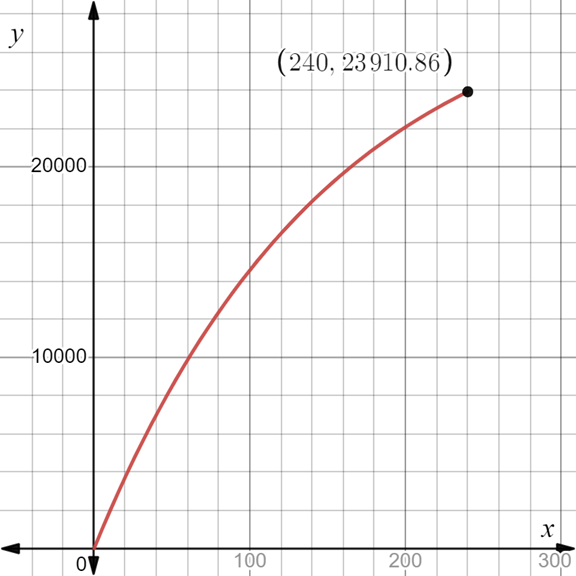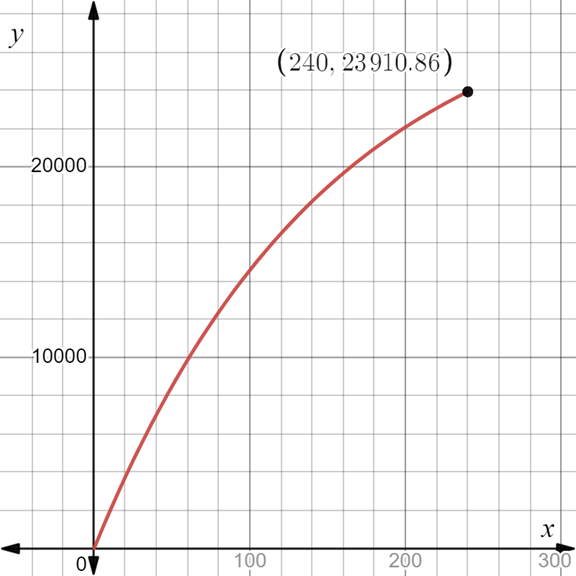
a.
To find: The annual interest rate.
The annual interest rate is 8%.
Given information:
The function describes the present value of a certain annuity, where x is time in months:
Concept used:
The present value PV of an annuity consisting of n equal payments of R dollars earning an interest rate i per period (payment interval) is
Explanation:
The annual interest rate is determined by the term 0.08 i.e., 8%.
b.
To find: The number of payments per year.
There are 12 payments per year.
Given information:
The function describes the present value of a certain annuity, where x is time in months:
Concept used:
The present value PV of an annuity consisting of n equal payments of R dollars earning an interest rate i per period (payment interval) is
Explanation:
Here, in the given equation “12” determines the number of payments per year.
c.
To find: The amount of each payment.
The amount of each payment is $200.
Given information:
The function describes the present value of a certain annuity, where x is time in months:
Concept used:
The present value PV of an annuity consisting of n equal payments of R dollars earning an interest rate i per period (payment interval) is
Explanation:
On comparing the formula,
i.e., The amount of each payment is $200.
d.
To compute: The present value of the annuity paying $200 monthly after 20 years.
The present value of the annuity is $23,910.86.
Given information:
The function describes the present value of a certain annuity, where x is time in months:
Concept used:
The present value PV of an annuity consisting of n equal payments of R dollars earning an interest rate i per period (payment interval) is
Explanation:
Substitute
The present value of the annuity paying $200 monthly after 20 years is $23,910.86.
e.
To graph: The present value function for x in the interval 0 to 20 years.
The graph of the present value function for x in the interval 0 to 20 years is shown.

Given information:
The function describes the present value of a certain annuity, where x is time in months:
Concept used:
The present value PV of an annuity consisting of n equal payments of R dollars earning an interest rate i per period (payment interval) is
Explanation:
By using graphing calculator, plot the given expression.

f.
To explain: The amount $23,910.86 is much less than the total of all 240 monthly payments of $200, which is $4800.
$23,910.86 is the present value of the annuity paying $200 monthly after 20 years.
Its future value will be much higher than $48,000.
$23,910.86 as present value would be a better option for now.
Given information:
The function describes the present value of a certain annuity, where x is time in months:
Concept used:
The present value PV of an annuity consisting of n equal payments of R dollars earning an interest rate i per period (payment interval) is
Explanation:
$23,910.86 is the present value of the annuity paying $200 monthly after 20 years.
Its future value will be much higher than $48,000.
Thus, $23,910.86 as present value would be a better option for now.
Chapter 3 Solutions
PRECALCULUS:...COMMON CORE ED.-W/ACCESS
- Use the growth rate of sequences theorem to find the limit or state it divergesarrow_forwardcalculate the maximum value of the directional derivativearrow_forward2. A tank with a capacity of 650 gal. originally contains 200 gal of water with 100 lb. of salt in solution. Water containing 1 lb. of salt per gallon is entering at a rate of 4 gal/min, and the mixture is allowed to flow out of the tank at a rate of 3 gal/min. a. Find the amount of salt in the tank at any time prior to the instant when the tank begins to overflow (650 gallons). b. Find the concentration (in pounds per gallon) of salt in the tank when the tank hits 400 gallons. D.E. for mixture problems: dv dt=11-12 dA A(t) dtarrow_forward
- - Suppose that you have the differential equation: dy = (y - 2) (y+3) dx a. What are the equilibrium solutions for the differential equation? b. Where is the differential equation increasing or decreasing? Show how you know. Showing them on the drawing is not enough. c. Where are the changes in concavity for the differential equation? Show how you know. Showing them on the drawing is not enough. d. Consider the slope field for the differential equation. Draw solution curves given the following initial conditions: i. y(0) = -5 ii. y(0) = -1 iii. y(0) = 2arrow_forward5. Suppose that a mass of 5 stretches a spring 10. The mass is acted on by an external force of F(t)=10 sin () and moves in a medium that gives a damping coefficient of ½. If the mass is set in motion with an initial velocity of 3 and is stretched initially to a length of 5. (I purposefully removed the units- don't worry about them. Assume no conversions are needed.) a) Find the equation for the displacement of the spring mass at time t. b) Write the equation for the displacement of the spring mass in phase-mode form. c) Characterize the damping of the spring mass system as overdamped, underdamped or critically damped. Explain how you know. D.E. for Spring Mass Systems k m* g = kLo y" +—y' + — —±y = —±F(t), y(0) = yo, y'(0) = vo m 2 A₁ = √c₁² + C₂² Q = tan-1arrow_forward4. Given the following information determine the appropriate trial solution to find yp. Do not solve the differential equation. Do not find the constants. a) (D-4)2(D+ 2)y = 4e-2x b) (D+ 1)(D² + 10D +34)y = 2e-5x cos 3xarrow_forward
- 3. Determine the appropriate annihilator for the given F(x). a) F(x) = 5 cos 2x b) F(x)=9x2e3xarrow_forwardTangent planes Find an equation of the plane tangent to the following surfaces at the given points (two planes and two equations).arrow_forwardVectors u and v are shown on the graph.Part A: Write u and v in component form. Show your work. Part B: Find u + v. Show your work.Part C: Find 5u − 2v. Show your work.arrow_forward
- Vectors u = 6(cos 60°i + sin60°j), v = 4(cos 315°i + sin315°j), and w = −12(cos 330°i + sin330°j) are given. Use exact values when evaluating sine and cosine.Part A: Convert the vectors to component form and find −7(u • v). Show every step of your work.Part B: Convert the vectors to component form and use the dot product to determine if u and w are parallel, orthogonal, or neither. Justify your answer.arrow_forwardSuppose that one factory inputs its goods from two different plants, A and B, with different costs, 3 and 7 each respective. And suppose the price function in the market is decided as p(x, y) = 100 - x - y where x and y are the demand functions and 0 < x, y. Then as x = y= the factory can attain the maximum profit,arrow_forwardf(x) = = x - 3 x²-9 f(x) = {x + 1 x > 3 4 x < 3 -10 5 10 5 5. 10 5- 07. 10 -10 -5 0 10 5 -101 :: The function has a “step" or "jump" discontinuity at x = 3 where f(3) = 7. :: The function has a value of f (3), a limit as x approaches 3, but is not continuous at x = 3. :: The function has a limit as x approaches 3, but the function is not defined and is not continuous at x = 3. :: The function has a removable discontinuity at x=3 and an infinite discontinuity at x= -3.arrow_forward
 Calculus: Early TranscendentalsCalculusISBN:9781285741550Author:James StewartPublisher:Cengage Learning
Calculus: Early TranscendentalsCalculusISBN:9781285741550Author:James StewartPublisher:Cengage Learning Thomas' Calculus (14th Edition)CalculusISBN:9780134438986Author:Joel R. Hass, Christopher E. Heil, Maurice D. WeirPublisher:PEARSON
Thomas' Calculus (14th Edition)CalculusISBN:9780134438986Author:Joel R. Hass, Christopher E. Heil, Maurice D. WeirPublisher:PEARSON Calculus: Early Transcendentals (3rd Edition)CalculusISBN:9780134763644Author:William L. Briggs, Lyle Cochran, Bernard Gillett, Eric SchulzPublisher:PEARSON
Calculus: Early Transcendentals (3rd Edition)CalculusISBN:9780134763644Author:William L. Briggs, Lyle Cochran, Bernard Gillett, Eric SchulzPublisher:PEARSON Calculus: Early TranscendentalsCalculusISBN:9781319050740Author:Jon Rogawski, Colin Adams, Robert FranzosaPublisher:W. H. Freeman
Calculus: Early TranscendentalsCalculusISBN:9781319050740Author:Jon Rogawski, Colin Adams, Robert FranzosaPublisher:W. H. Freeman
 Calculus: Early Transcendental FunctionsCalculusISBN:9781337552516Author:Ron Larson, Bruce H. EdwardsPublisher:Cengage Learning
Calculus: Early Transcendental FunctionsCalculusISBN:9781337552516Author:Ron Larson, Bruce H. EdwardsPublisher:Cengage Learning





